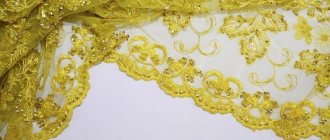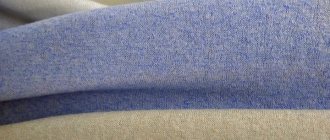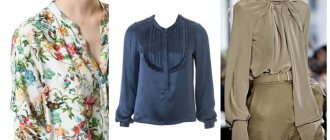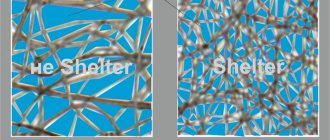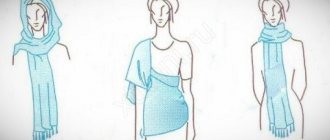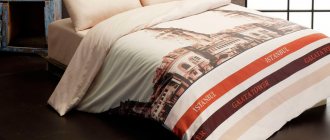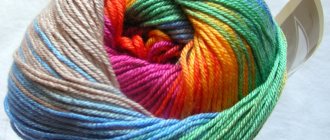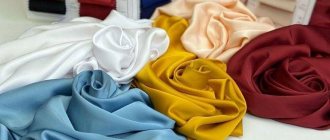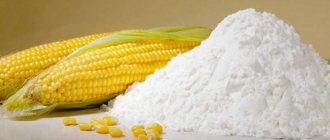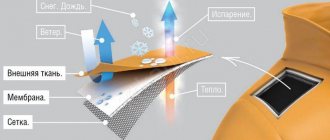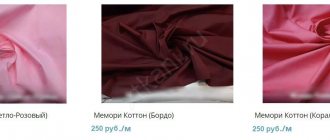Cashmere is a soft, airy and warm fabric used to make luxury clothing. Cashmere contains only natural high-quality fluff, the cost of which is quite high. But products made from expensive material remain elastic, stylish and beautiful for decades. You can often see movie stars on the covers of fashion magazines wearing simple dresses and cashmere jumpers. This confirms that cashmere fabric is a symbol of wealth and high position in society.
What type of fabric is this
Cashmere is a warm, delicate, soft, airy material. Typically used to produce high-end clothing. The composition of the product is high quality animal down. Once a year (May, June) it is collected during the molting of goats. Special scallops are used. The diameter of the villi is 6 times thinner than human hair.
The resulting raw materials are sent for cleaning and degreasing.
One animal produces about 180 g of primary material. After processing, less than 100 g remains. Losses are about 50%.
Cashmere shades
The next step is to sort the thread by thickness and spin it. The work is done manually. The fibers are then dyed.
There are two types of yarn: pashmina (delicate fluff, cross-section no more than 15 microns), semi-pashmina (cashmere) fiber thickness is about 19 microns. After all the above procedures, the threads are sent to weaving factories.
Fabrics are made in two ways - twill weave or knitted (knitting).
HOW TO DISTINGUISH REAL CASHMERE FROM SYNTHETICS BY TOUCH?
Place your palm on the cashmere scarf. After a few seconds, you will feel how it is filled with warmth, how the warmth spreads over your hand and warms you. This means that this is a real cashmere item. After all, its main purpose is to warm.
The ability to warm is explained by the habitat of mountain goats. They live high in the mountains, where winter temperatures rarely rise above -40-45 degrees. A thick and warm undercoat protects goats from the piercing wind and severe frost. The stronger the frost, the warmer it is.
Origin story
It is unknown who first came up with this method of obtaining excellent material. The name cashmere comes from the province of Kashmir, which is located in India. The fabric was first heard of in the 12th century. The book of the Persian kingdom depicted shawls made of amazing fiber.
Napoleon brought the material to Europe. From the countries of the East he brought a gift to his wife - a transparent shawl with elaborate embroidery. Josephine was delighted. After this, supplies of the product to Europe became constant.
In the nineteenth century, industrialists in this region began to try to create fabric themselves. Only the Scots succeeded. They did not raise sheep in their homeland, but began to import raw materials from China.
Royal versatility
Read about: trip - fabric with royal dignity.
The wonderful fabric is incredibly versatile. It is used to make blankets for newborns and a wide range of products for adults. The standard of chic and luxury are cashmere coats, berets, shawls, cardigans, gloves, dresses, skirts and even trousers. The East is also famous for its magnificent hand-made cashmere carpets.
But the “wool diamond” is very expensive. Its price depends on the fineness of the fibers, the size of the product and the original color of the raw materials. The natural color of down is white, beige, gray or black. The most expensive is white, it can be painted in pure colors. A special feature of cashmere is its smokiness and some blurred color. In order for the color of the product to be rich and fresh, wool or silk is added to the composition.
Fabric composition and its properties
Traditional high quality natural cashmere is 100% wool obtained from mountain goats. You will not find any other components in its composition - neither natural, nor artificial, nor synthetic.
Often, to reduce the cost of goods, manufacturers add to the composition: Angora rabbit fluff, the undercoat of other goats, or a synthetic analogue. All these “additives” change the original characteristics of the material.
Cashmere is the finest wool material in the world. Thin down threads give the product lightness and softness. The material is considered hypoallergenic. It retains heat well, but clothes made from it are not hot (goat hair is an excellent thermostat).
The fabric is elastic, strong and durable. The appearance of pellets on it is almost impossible. It does not wrinkle or stretch. The healing effect is another property of high quality cashmere. It will help get rid of muscle spasms and joint pain.
Scope of application: what is sewn from cashmere, what is it used for
The choice of cashmere items is quite large. Depending on the method of processing the yarn, fine knitwear, suit or coat fabrics can be distinguished. The yarn is often used to make very thin shawls or scarves that can literally be passed through a ring. Cashmere outerwear looks extremely expensive and respectable, but when worn it requires increased care and proper care. It is much more practical to buy a sweater, dress or hat that will delight you for many years, keeping you warm in cold weather.
Types of fabric
Nowadays, manufacturers offer several options for the “performance” of the material. It all depends on the method of production of the thread:
- Mongolian. The raw material is the down of Chinese and Mongolian goats. The threads are processed by hand. The resulting fabric is high quality, soft and without pilling.
- Coat. Composition: cashmere goat wool (30%), wool from other animals (70%). The most famous and sought after type of cashmere. It has a homogeneous structure. It doesn't wrinkle or roll down. For expensive products, double-sided fabric is used (no lining required).
- Eco-cashmere. Considered inexpensive. Composition: polyester and viscose in a ratio of 80/20%. There is no animal undercoat in it. Therefore, such a property as thermal conductivity is less pronounced.
Recommendations for caring for warm cashmere products
Cashmere wool, more than other types, needs careful and delicate care. Only mild detergents are used, which can be replaced with baby soap or shampoo with a neutral pH level. Washing items is done manually, or using a delicate cycle in some models. Pre-soaking is not recommended; it is advisable to use only warm or cool water during the process.
Explanation of meanings
Products made from cashmere and taffeta should not be twisted or wrung out strongly; it is best to dry items in a straightened state. For this purpose, soft fabric towels that absorb moisture well are usually used. Cashmere clothing does not need ironing. Wrinkled areas of fabric can be treated with steam, tight-fitting items will straighten out while wearing.
Natural wool quickly absorbs foreign odors. You can get rid of this not only by washing, but also by airing the item in the fresh air. It is ideal to choose cloudy weather immediately after rain.
Cashmere is extremely attractive to moths, so it is also advisable to consider special conditions for storing items. Clothes should be regularly “ventilated” in the fresh air, and use folk or store-bought insect repellents. Thin items should not be stored on a hanger, as this may cause the item to stretch. When the right season arrives, it is best to treat clothes with a steam generator at the minimum temperature setting.
Pros and cons of cashmere
Advantages:
- lightness and weightlessness;
- hypoallergenic;
- strength and durability;
- low thermal conductivity (under any conditions, clothes made of this material will be comfortable;
- pellets appear occasionally (in the area of contact between the canvas and the canvas);
- natural wax contained in the thread cares for the skin;
- has a healing effect.
Flaws:
- difficult fabric care;
- high price.
Description
Cashmere (French: Cachemir) is twill weave wool obtained from the fluff (undercoat) of mountain, Kashmir goats. The fabric is thin, soft and warm. The origin of the name is associated with the region of Kashmir in the northwestern part of Hindustan, in the highlands of the Himalayas.
Goats are grazed in Pakistan, India, China, Mongolia and Nepal to obtain raw materials. In other places of traditional sheep farming, such as Scotland, New Zealand and Australia, it was not possible to breed Kashmiri goats due to different climatic conditions. The quality of the fleece is low and devoid of features.
Types of cashmere yarn depending on the knitting method and calculation
The easiest way to determine the quantity is to strictly follow the chosen knitting pattern. However, if you need to make deviations to achieve the result, you can determine the thread consumption yourself.
Calculation for knitting needles and hook
For hand knitting using knitting needles and crochet, cashmere yarn is sold in small skeins of 50 and 100 grams. Due to the small thickness of the thread and its lightness, 500-700 meters can be placed in one such skein.
But it’s too early to rejoice, these same qualities of the thread require work in several folds, usually from 3 to 6. The more folds of the thread, the thicker the knitting turns out. But the footage of one skein decreases proportionally.
To correctly calculate the required amount, they resort to the only correct method - experiment.
- You need to purchase one skein of the desired yarn and knit a small sample of 10*10 cm according to the chosen pattern. Finish knitting by cutting the thread.
- The resulting number of loops and rows must be counted and carefully written down in a notebook so as not to forget.
- Unravel the sample and measure the length of the thread. Record the result.
- Calculate the area of the future product using the mathematical formula: length multiplied by width. The result obtained must be multiplied by the length of the thread from the sample.
- Divide the resulting length by the length of one skein.
The result will be the required number of skeins, which must be rounded up. Cashmere yarn should always be purchased with a small reserve so that there is definitely enough for the entire model.
We talk more about choosing threads for knitting in this article.
Calculation for machine knitting
For machine knitting, there is special yarn in large bobbins of 1 kg or more. The thread is wound on a rigid spool, which is conveniently placed in a knitting machine. The yarn in such bobbins is very thin and is always used in several plies.
For thinner fabrics, use 2 to 3 threads; 4 or more threads produce a denser and thicker fabric.
You can divide one bobbin of cashmere into several pieces using a special winder. When winding, the thread is treated with paraffin. This is very important, since in order for the knitting machine to work without failures, the winding must be correct.
The required number of threads is also calculated experimentally. To do this, 40 rows are knitted on 60 needles. To ensure accurate results, a sample is taken no earlier than 24 hours before starting work. The washed and ironed scrap is laid out on a flat surface and measured. Based on the results obtained, the consumption is determined.
Bobbin yarn has a number of advantages over skein threads. It is, as a rule, of excellent quality, and at the same time costs much less than its analogues. Thrifty needlewomen prefer to buy such bobbins at stock sales of famous clothing brands.
But when choosing cashmere in bobbins, you should remember that rewinding without a special winder can be a significant disadvantage, taking a lot of time and effort.
Production
Natural cashmere is a woolen material that is pleasant to the touch, but rare and expensive. The fluff is plucked and combed from animals during the spring molting period, then cleaned, dyed and spun into fine threads. All work is done manually. One goat is capable of producing about 200 g of raw cashmere per year, and after processing it only 100-120 g remains. Thus, for one shawl, down is collected from 3-4 goats, and for a midi-length coat, up to 15 animals will need to be processed. It takes about a month to receive the yarn. This explains the high price of clothing. You can simply say what cashmere is - warm clothes made from elite goat down.
The natural fur color of the Tibetan goat is white, gray, black or brown. The raw material does not dye well, and cashmere material has the same colors or close to them. Thin downy white fibers are dyed better, but retain their characteristic “smokiness”. Dark fibers remain dull after dyeing.
Recognized global cashmere brands are Italian companies that own technologies for cleaning and weaving goat down, “Ballantyne”, “Brunello Cucinelli”, “Agnona”. And also Scottish, with a long tradition of producing woolen fabrics, “Pringle of Scotland”, “Lyle & Scott”.
